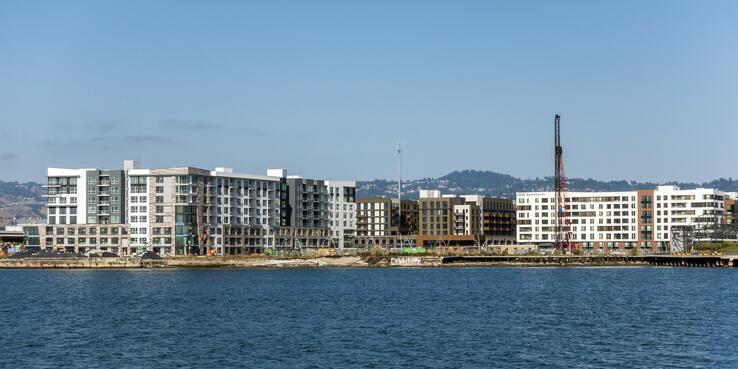In 2023, the City of Oakland launched what it describes as a “once-in-a generation” opportunity to create a visionary blueprint for the city’s future. As part of its 2045 General Plan Update, the city opened the door to public comments on its first-ever Environmental Justice Element and its draft Safety Element, two plan elements of interest to SPUR’s sustainability, resilience, and social equity policy efforts.
SPUR worked with our Oakland Policy Board –– a group that includes Oakland representatives from private industry, local-community-serving nonprofits, and academia –– to develop recommendations and submit advocacy letters for both elements. The city took up some of those recommendations, proving it pays to chime in with well-researched policy positions. The adopted language reflecting those recommendations means that Oakland is poised to support multiple food assistance programs, reduce the potential for post–earthquake fires and building collapse, and begin to address an under-recognized climate change risk: groundwater rise.
Environmental Justice Element
One of SPUR’s recommendations for Oakland’s draft Environmental Justice Element –– an element new to the General Plan –– was adopted in the updated element using our language. Our recommendation was to expand the section on healthy food access to include support of multiple supplemental food assistance programs, not just CalFresh. SPUR urged the city to supplement CalFresh benefits through programs such as Market Match, Fresh Creds, and SPUR’s Double Up Food Bucks program. Many of these programs already exist in Oakland, but lower-income residents could benefit greatly from their expansion.
Safety Element
Three of SPUR’s recommendations to the City of Oakland regarding the city’s draft Safety Element were reflected in the updated Safety Element, which was adopted in late September.
Recommendation: Include specific actions related to mitigating structural hazards of both new and existing buildings in the face of a major earthquake.
Outcome: Oakland included creation of an inventory of existing non-ductile and tilt-up concrete buildings –– two older types of buildings at risk of collapse during a major earthquake due to structural deficiencies. The action stated that the city will explore the development of an ordinance to require retrofitting of these two vulnerable building types. Unfortunately, SPUR’s recommendation for the city to encourage or require new buildings to be designed for timely recovery after an earthquake through seismic performance targets was not included in the updated element. This policy is more difficult to adopt for many reasons, although the City of Alameda was able to include a similar policy in its recent Safety Element update. SPUR will continue to advocate for new and existing buildings and infrastructure to be designed and retrofitted with recovery in mind.
Recommendation: Include up-to-date information on Oakland’s groundwater rise risk and take action on this hazard through the development of a shallow groundwater rise vulnerability assessment that includes information on the impact of groundwater rise on contaminated sites.
Outcomes: To address these two actions, SPUR offered model policy language pulled from OneShoreline’s Sea Level Rise Draft Planning Guidance, released in April 2023. Oakland adopted both actions using OneShoreline’s model policy language. That’s a huge win because recent studies have shown that parts of Oakland, specifically low-lying neighborhoods with a large share of residents of color, such as West Oakland, are at risk of groundwater rise, which occurs as sea level rises, and saltwater pushes groundwater up through the soil, leading to higher groundwater tables along the shore. Those higher groundwater tables increase flood and liquefaction risk and mobilize underground contaminants at toxic sites, as explained in this SPUR article.
Recommendation: Include information on actions the city has already taken to mitigate urban fires (especially in the wake of the 2016 Ghost Ship Fire) as well as future actions to reduce the potential of post–earthquake fires, such as requiring the installation of automatic gas shutoff valves in existing buildings.
Outcomes: The updated Safety Element included a section on Oakland’s 2016 Ghost Ship warehouse fire that killed 36 people. The section references Executive Order 2017-1, Improving Safety of Non-Permitted Spaces While Avoiding Displacement, which directed the city to “take action to preserve housing, workspaces, and cultural gathering spaces while improving life safety in unpermitted buildings.” The city has continued work on this executive order by bringing buildings into compliance, increasing inspection capacity and protocols, improving interdepartmental communications, strengthening tenant protections and education, streamlining event permitting, and identifying housing resources. The city also agreed to consider an ordinance requiring the installation of automatic gas shutoff valves in existing buildings at the time of sale and the transfer of title or when upgrades are planned for gas piping to reduce post–earthquake fires.
Work to Do
SPUR will continue to push for change in the areas where our recommendations were not ultimately adopted. One priority: The city took no action on our recommendation to update the city’s post–disaster recovery plan and to include further commitments for supporting socially vulnerable communities during recovery by, for example, mitigating residential displacement.
Oakland’s 2021 Local Hazard Mitigation Plan directed the city to develop a post–earthquake disaster action plan that included grant funding opportunities and debris removal strategies. Yet no guidance for this action was reflected in the adopted Safety Element. SPUR recommended that the city update its 2010 disaster recovery plan, prepared by the Association of Bay Area Governments, to develop more detailed emergency housing strategies as well as strategies to support equity-priority communities –– census tracts with a significant concentration of underserved populations, such as households with low incomes and people of color –– through a disaster recovery process. The 2010 plan broadly covers financing, government, housing, school, business, infrastructure, and healthcare recovery in the wake of earthquakes and other disasters.
SPUR commends the City of Oakland for its work on the Safety and Environmental Justice elements and appreciates its direct response to our recommendations. We will continue to advocate for the City of Oakland to advance equity-focused disaster recovery planning to protect vulnerable residents and minimize residential displacement.
